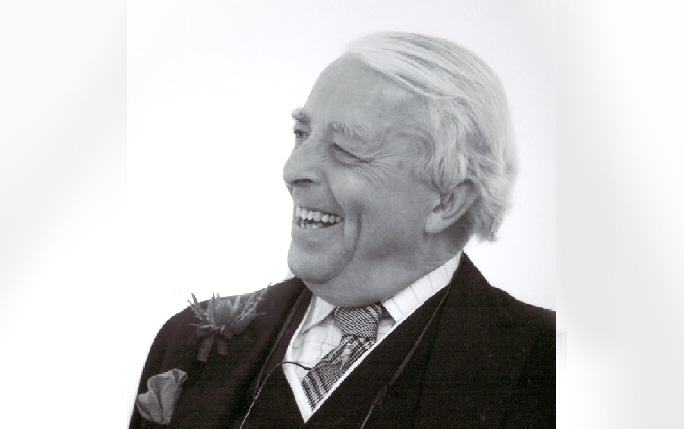In memoriam: Anthony Jaggard 1936- 2020

The University of Liverpool is saddened to hear of the passing of Liverpool School of Architecture alumnus, Anthony Jaggard (1936 – 2020).
Anthony Jaggard, renowned architect, designer, conservationist, and aesthete, known for his breadth of knowledge across the arts which transferred not only into wide ranging creativity in his professional field of architecture but also into his recreations. Jaggard was a founding entry in Debrett’s Distinguished People of Today.
First briefly working for Goodhart-Rendel and then based in Dorchester with John Stark and Partners, Jaggard’s successful career, was unusual as a non-RIBA member who worked on both historic and new buildings across the country from Callaly Castle in Northumberland and Hoddam Castle in Dumfriesshire, Kesworth in Dorset, Hedsor Wharf in Buckinghamshire, Ince Castle in Cornwall to Bellamont House in Dorset. His most well-known creation was the neo-Georgian Lulworth Castle House, designed in 1975 for his brother-in-law Wilfrid Weld, while his greatest triumph was the modernist St. Joseph’s Roman Catholic Church, Wool built in 1971 for his father-in-law, Sir Joseph Weld, which became a Grade II listed building in 2013.
This pioneered the use of an industrial triodetic space frame to achieve a single span and an uninterrupted space for worship and a masterful simplicity of design. His new build neo-gothic revival Bellamont House was nominated in 2002 as Country Life’s House of the Year and his ground-breaking High-Tech Roman Town House conservation project in Dorchester won the Dorset Archaeological Award and was shortlisted for the British Millennium Archaeological award in 2000. Although by nature a traditionalist, his predominant design characteristic was taking the time to get to know his clients (many of whom became lifelong friends) and designing to their requirements and tastes. He delighted in spending time researching and designing minor detail as well as the large-scale design.
Anthony John Thorrold Jaggard was born in Northampton, the son of the Reverend Arthur William Percival Jaggard and May Louise Capell of Flore. His father was a scholar of ancient languages and had been President of the Durham University Union in 1908. Jaggard’s maternal grandfather had been the architect Bruce Capell and one of his godparents was an Anglican Bishop. With such influential strands on his life, it is perhaps unsurprising that he himself stretched to a “broad church”. After school at Bedford he went on to study Architecture at Liverpool University, where he converted to Roman Catholicism.
He won the School of Architecture’s travelling scholarship which took him to Portugal and launched a lifetime interest in ceramic tiles. At the same time, he began his lifelong pattern of networking; joining the Cheshire Yeomanry, subsequently becoming a magistrate, and a member of the Dorset Council of St. John, the Georgian Group, the Victorian Society, the Royal Archaeological Institute, the British Archaeological Association, and the Royal Society for the Encouragement of Arts, Manufactures and Commerce (FRSA). He was elected a Liveryman of the Worshipful Company of Painter Stainer’s and Fellow of the Society of Antiquaries of London (FSA). He was also noteworthy as the only Roman Catholic member of the Anglican Salisbury Diocese Redundant Churches Committee.
His lifelong love of the arts led him to commission work from a range of artists many of them setting out on their careers which included Geoffrey Teychenne, Kyffin Williams, Richard Shirley Smith, Binny Mathews, Toby Ward and David Roper-Curzon. His long relationship with the Dorset County Museum saw him drive the fundraising for and commissioning of Elisabeth Frink’s statue of the Dorset Martyrs. He later became President of the Dorset Natural History and Archaeological Society who are the custodians and owners of the County Museum.
A person of principle he was not a flatterer and was always happy to speak his mind no matter how unpopular and inflicted his jokes on everyone even-handedly. This did not get in the way of a serious academic mind with an encyclopaedic ability to visually recall; correcting the Museum of Cairo, and the Met in New York on the inaccurate labelling off their exhibits or simply doing so at previews to auctions at Duke’s in Dorchester. He did not seek to gain fame through his work, but it will have a lasting influence on the English country house and its associated buildings (he was for many years a judge for the Country Landowners’ Association buildings awards), and museums and churches throughout the Southwest have benefited from his efforts.
Anthony Jaggard is survived by his wife Janie, a son, three daughters, ten grandchildren and one great-granddaughter.